Have you noticed sediment or particles in your water? Can you smell strong chemical odors in your water and want to make it safe to drink? Are your appliances and faucets becoming encrusted with mineral deposits, making them ugly and shortening their lives?
These are the very things I can help you fix.
Why Filter Your Water?
Everyone needs clean water, but as you’ve probably read or seen in the news over and over, you can’t count on clean, safe water at your tap, even if it comes from a town treatment plant.
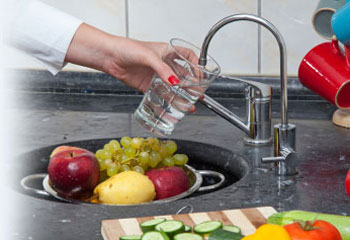
In fact, many science research papers have been written about how environmental pollution and heavy industrial pollution has found its way into most tap and well water.
These contaminants can at the least, make the water taste bad, at the worst, lead to long-term health problems.
On the news, you’ve likely seen one emergency after another where drinking water has been seriously contaminated and affected tens of thousands of people. Often times, people were consuming tainted water long before they were even aware of the contamination.
Practically all sources of drinking water, from above ground sources like lakes, rivers, glaciers and such, to underground sources like groundwater and aquifers, and even treated water from municipalities have some level of contamination.
You’re right to be concerned. You’re right to filter your water.
Doesn’t The Local Treatment Plant Make My Water Safe For Drinking?
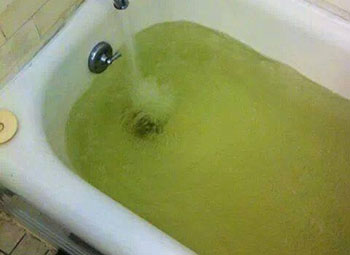
Today, there are literally thousands of chemicals in the environment that weren’t there decades ago. Industrial processes and pollution, agricultural, residential and natural contaminants find their way into water sources continuously. Municipal drinking water plants, as good a job as they do, cannot and do not remove all of them. Additionally, in order to disinfect the water from live pathogens, they’ll add their own chemical contaminants to the water to kill them. The chemicals they use, like chlorine and fluoride are themselves scientifically known to be harmful to humans and animals.
While many contaminants have been removed from the water and microbes have been killed off, contaminants like pharmaceutical drugs, chemicals and heavy metals may still be in the water after municipal treatment. Additionally, new microbial and chemical pollutants may enter the water stream en route to your home.
How Bad Can the Quality of Groundwater Really Be?
The leading worldwide cause of death and disease is caused by consuming contaminated groundwater or bodies of water. This isn’t just in remote places, it routinely occurs in developing and industrially developed countries, as well.
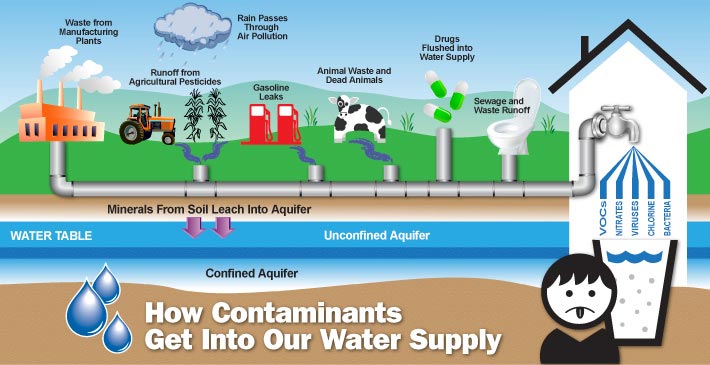
Anything can affect the purity of water, from natural disasters and human activity, such as pumping the ground with toxic fracking fluids. Nearly half of all bodies of water in the United States are classified as being polluted.
We cannot trust that our water is safe to drink or even bath or shower in.
8 Real Benefits of Filtering Your Own Water
1. Clean-tasting Water: Even the most basic carbon filter will provide better tasting water by removing chemical smells and flavors.
2. Healthier Water: By filtering your drinking water, you’ll have eliminated many things that may be affecting the health of you and your family.
3. Confidence: When you filter your water, you’ll be confident that you are not consuming harmful pesticides, herbicides or heavy metals.
4. Chemical Free: By filtering your own water, you can avoid the harmful chemicals that leach into water from plastic bottles. If you decide to go with a more capable Reverse Osmosis system, in addition to general filtration, you can also be sure that your drinking water is free of harmful chlorine and fluoride chemicals and free of many other environmental contaminants.
5. Cost Effective: Although your purchase of a filter system will cost you up front and in replacement filters, you will save a lot of money as compared to continuously buying bottled water.
6. Convenience: Once your filter system is installed, you’ll realize how convenient it is to be able to just turn the tap and have clean, purified water flowing into your travel mug, drinking glass, or cooking pot.
7. Improves Your Health: The habit of drinking purified water will help keep your organs and immune system healthy. It also has a large impact on the health and youthful appearance of your skin. See my post on the Skin Benefits of Drinking Water.
8. Helps the Environment: By filtering your own water at home, instead of buying bottled water, it will save you from having to deal with hauling all that heavy bottled water, and dealing with all those empty bottles afterwards. If you live in a state that doesn’t mandate a return policy, most likely all those bottles are going into a landfill nearby.
What’s in My Water? Should I have it Tested?
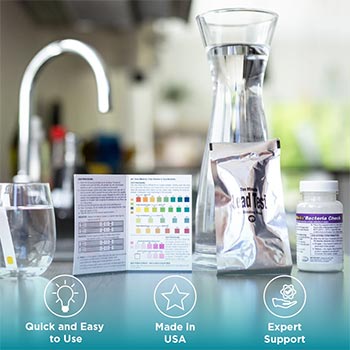
Regardless of your water source, it’s a gamble to just assume your water is safe to drink, shower or bathe in. You’ll never know what’s in it unless you test it. Even if water supplied to your house is free of lead, pipes in older houses may be leaching lead into the water.
If you suspect lead contamination, test every faucet that your family is likely to use for drinking purposes. Lead-test kits from the hardware store are fairly accurate and inexpensive.
Some, but not all, pitcher and faucet water filters can remove lead. Make certain that the filter you select is certified by NSF International to remove lead.
If you suspect other contaminants, like agricultural or industrial chemicals, you’re going to want a better quality water test kit, or send a water sample to a lab for a more detailed analysis, both available through FilterWater.com
If you get your water from a public water system, your water is being monitored and tested regularly. Results from these tests are reported to state and federal agencies that are to assure that the National Drinking Water Standards are being met.
Sometimes, water reports are automatically sent to customers on an annual basis, but if you don’t receive one, by law, water utilities must send a free water quality report when it’s requested.
Your water company is supposed to notify its customers and government agencies of any contaminants that happen to pass through their system and into the water supply, but as we’ve repeatedly seen over the years in the news, many times the public has consumed highly contaminated and even toxic water, long before the contamination was ever shared with the public.
You can’t always trust that your water supply is safe.
Your Own Private Water Supply
If your water comes from your own private source, you alone, dear owner, are responsible for making sure it’s safe to drink.
Therefore, you should set a schedule to test it regularly, perhaps once a year.
You may want to visit the EPA’s site for information on Home Water Testing.
Buyers Guide: How to Find the Right Filter System For You
Things to Consider:
- Do you live in a small apartment or dormitory where you must use a small countertop filter?
- Do you own your house, where you can install a full under the sink system?
- Do you get your water from a city or town utility, or from a private well?
- Do you live near industry or farms?
- Do you want a simple filter that will just take care of chemical smells and tastes from the water?
- Do you want a complete filter system that will virtually eliminate all contaminants from your water?
- What’s in your water or do you know specific contaminants you want to filter?
- What is your budget?
Filter Capacity
Generally speaking, the larger the physical size of a filter cartridge, the more filtering capacity it will have. This is just a general rule. There are many other factors that determine the ability of a filter to do its job of removing contaminants from drinking water. Quality varies dramatically between filter brands, which we will visit in the reviews.
Filters are engineered to specifically remove certain types of pollutants. Filters will separate contaminants either mechanically, or chemically.
Mechanical filters will purify by forcing water through a porous filter material like spun nylon, or a synthetic foam material, or other types of spun fiber pads. These materials are very good at capturing larger particulates from the water like dirt and silt from the water.
A sediment filter is a very common mechanical filter. A Reverse Osmosis filter membrane is a very high-tech, mechanical type filter that is capable of removing contaminants on a far smaller, microscopic scale.
Chemical filters purifies water by capturing substances through a process of adsorption, as opposed to absorption. Absorption is when one material will soak up or entrap another material, as happens with most mechanical filters.
Adsorption is the process of capturing impurities and toxins with chemical bonds, binding to the filter material, as the water flows across the material and through the filter cartridge. This effectively pulls the contaminants from the water stream. An activated carbon filter is a good example of a chemical filter.
A filter system that incorporates several stages of both mechanical and chemical filtration will be more effective at purifying water.
Ease of Changing Filters
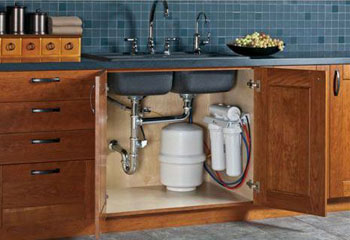
It’s important to consider the ease of changing out the filters. While counter-top filters might be more accessible, they are not nearly as effective as under-counter systems at removing contaminants.
Counter-top water filters take up valuable counter space or refrigerator space. Additionally, you have to change the filters and add water to them frequently. They are just not as convenient or as effective as under-counter water filters.
A filter system that’s installed in the cabinet under the kitchen sink is accessible, long-lasting and convenient.
Filter Life Span
Under the counter filter systems have an advantage over countertop water filters in that the filters last for months. Under counter water filters are generally larger filters. This in itself will allow them to last longer than smaller, filters. This means you’ll enjoy the convenience of having pure water without the frequent maintenance of countertop type filters.
Amount of Waste Water Produced
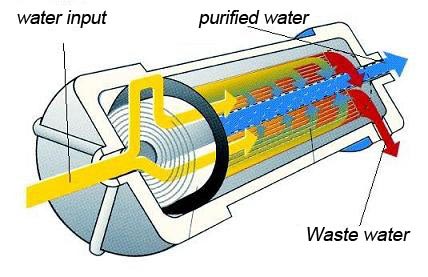
Reverse osmosis systems use a combination of mechanical and chemical filters, in addition to using the ultimate filtering ability of the RO membrane, to produce an unmatched filtering system.
Early models of Reverse Osmosis systems sent four gallons of water down the drain for every gallon of filtered water produced. Today, some RO systems have built-in features that greatly minimize water waste.
For low water pressure situations, adding an optional electric permeate pump will boost water pressure that the reverse osmosis filter needs to work properly.
Some manufacturers have introduced an Auto Shut-off valve that shuts off water flow through the filter system, once the storage tank is full. This one improvement considerably reduces waste water. You’ll learn about this feature in the reviews.
Filter Types and Current Technologies
Countertop Water Filters:
Pros:
- Low initial cost and fast set up
- Easy to use and to maintain.
- Different models and brands have different effectiveness.
Cons:
- Takes up counter space.
- Short filter life, must replaced frequently
- Must be refilled with water often
- Long-term expense is more than under counter filter systems
- Not as effective as under counter systems
- Filtering is slow
Click here to see the Top Rated Countertop Water Filters available
Carbon Water Filters:
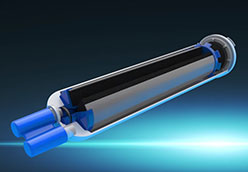
Carbon is perhaps the most common material used to remove impurities from water. There are two types of carbon filters and each has advantages and disadvantages. There is Granular Activated Carbon, and Solid Block Activated Carbon.
The term “activated” is used when the carbon material has been modified to create extra surface area within the material to for more filtering ability. It’s a high-temperature process that creates a matrix of millions of microscopic crevices and pores in the material.
Activated carbon is also referred as “activated charcoal”. This material is ideal for capturing chemicals and unwanted tastes and odors from water.
Carbon filters are usually used in combination with other types of filters.
Pros:
- Removes chlorine and other dissolved organics very effectively
- Carbon filters have long life
- Reverse Osmosis Systems place carbon filters before and after the RO filter, making it a much more effective and well rounded water purification system.
Cons:
- Alone, carbon filtering is not as effective at removing total dissolved solids, water hardness or heavy metals.
- When installing a fresh carbon filter, it’s recommended to flush the first few gallons through it to eliminate any fine carbon particles in the water. This flushes any loose particles away.
Ultrafiltration (Microporous) Filtration
Ultrafiltration filters will screen out much smaller suspended solids and particles than carbon filters, but not as small as a Reverse Osmosis filter does. These filters can be used as the primary means of filtration or as a pre-filter to protect a downstream reverse osmosis filter from premature clogging (fouling).
Pros:
- Effectively removes most suspended solids and microorganisms
- Produces high-quality water.
Cons:
- Won’t remove dissolved organic compounds.
Reverse Osmosis
Reverse Osmosis (RO) filtration is one of the most effective and economical ways to purify water. It’s used industrially in large systems to purify water, but you can choose from several manufacturers of RO systems developed to purify drinking water right at home.
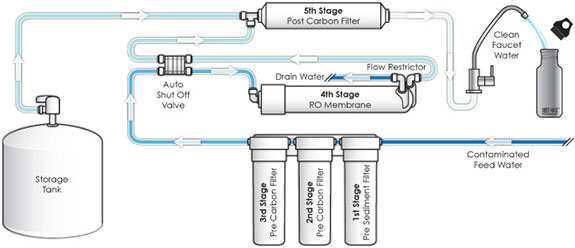
These amazing filter systems are capable of eliminating contaminant sizes down to 0.0001-0.0005 microns in diameter, much smaller than ultra-filters.
This is small enough to remove virtually all microbial contaminants like bacteria and viruses, particles, and most dissolved organic contaminants and inorganic compounds.
See post: How Does Reverse Osmosis Work to learn more about how RO works.
Pros:
- Removes all kinds of contaminants to a very high degree of purity.
- Reverse Osmosis produces water that is much purer than can be produced with countertop and water faucet filters.
- Once fresh filters are installed in an RO system, you can go for many months before needing to replace the filters again.
- Requires minimal maintenance.
Cons:
- The RO filter is very restrictive, which limits the flow and quantity that can be produced each day. However, the storage tank that’s provided with these home systems is usually large enough to prevent shortages of filtered water for the whole family.
- Uses water to flush contaminants down the drain. In the latest systems, manufacturers have introduced clever and effective ways to minimize this waste.
Click here to see the best residential Reverse Osmosis Systems available.
Activated Alumina Filters:
Countertop water filters are not as effective as reverse osmosis at removing contaminants, such as fluoride, arsenic and selenium. However, some countertop filters employ the use of Activated Alumina, in which water is filtered down through a bed of granulated activated alumina to remove pollutants.
Despite some misinformation on the internet, activated alumina filtration does NOT add aluminum to the water it filters. Source: https://www.purewaterproducts.com/articles/activated-alumina
Pros:
- Demonstrated to be effective at removing fluoride from water.
- Does not alter the composition of the water
Cons:
- Does not disinfect the water from microbes.
Distillation Water Filtration:
A Countertop Distiller appliance can make small production of pure, distilled water easy. The appliance is first filled with tap water, which is then heated to boiling. Water vapor rises to the top of the vessel, leaving virtually all contaminants behind. A condenser then cools the vapor back into water. This purified water is then directed out of the spout and into a glass decanter.
Pros:
- Removes a wide range of contaminants for very pure water
- No filters to replace
- Easy maintenance
Cons:
- If pesticides and herbicides exist, they can be carried into the condensate.
- Consumes large amounts of energy – about $0.46 per gallon.
- Very slow process: Takes about 5 hours to make 1 gallon of distilled water.
- Loud hum of fan, which runs continuously.
- Takes up space on the counter.
- Water can be acidic – should be stored in glass containers.
- Lacks oxygen, minerals and some say has a flat taste.
Click here to see the best Home Water Distillers.
Conclusion
As industrial, agricultural, pharmaceutical and natural pollutants have contaminated much of our water resources, you’re right to be concerned for your health and wanting clean drinking water for you and your family. For these reasons, you must consider using some kind of water filter.
Whether you want to purify your drinking water, to filter your shower water, or to filter all the water that feeds your home, these filters and systems are the best in the industry.
Come on, let’s take a look…
